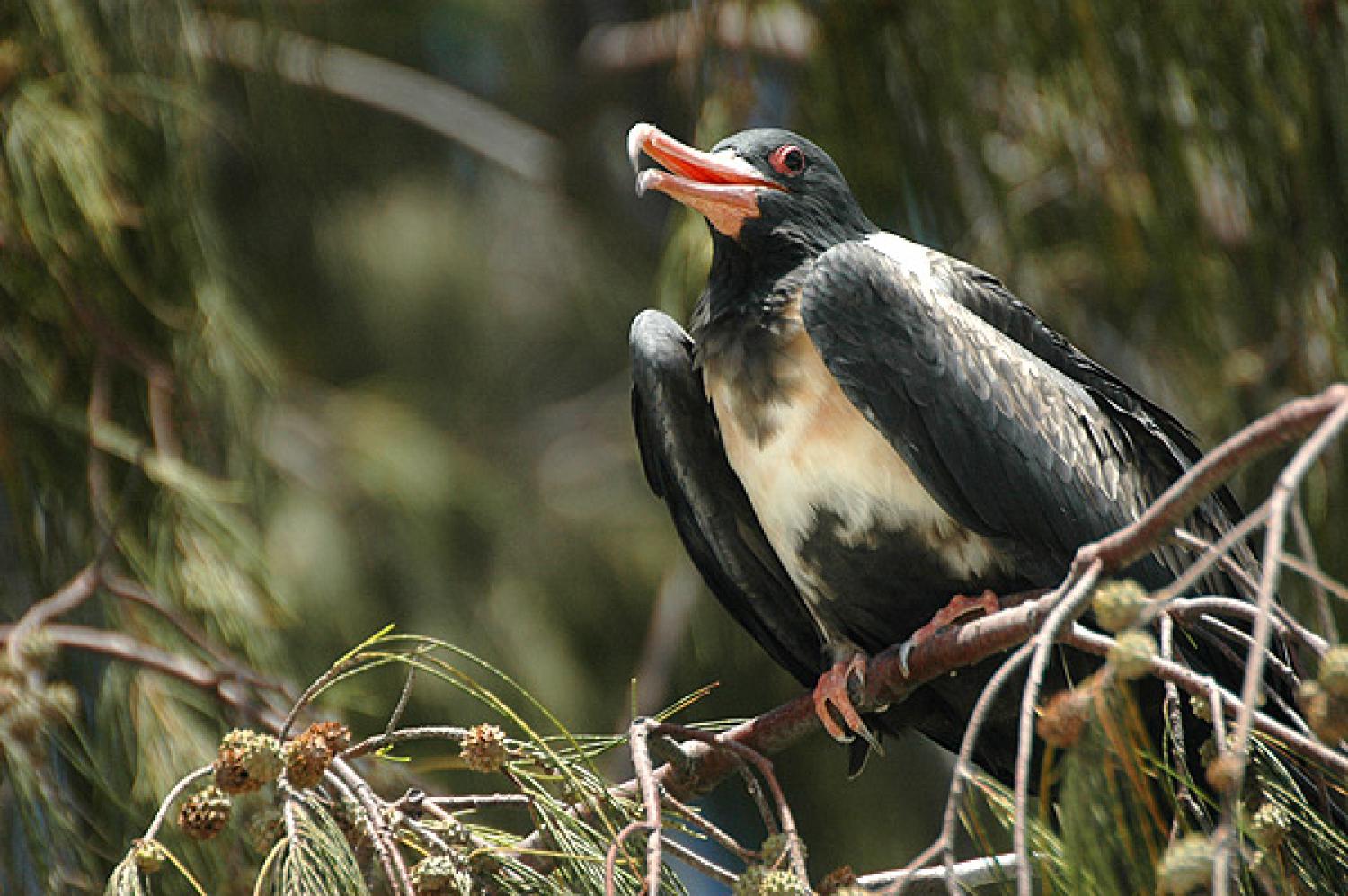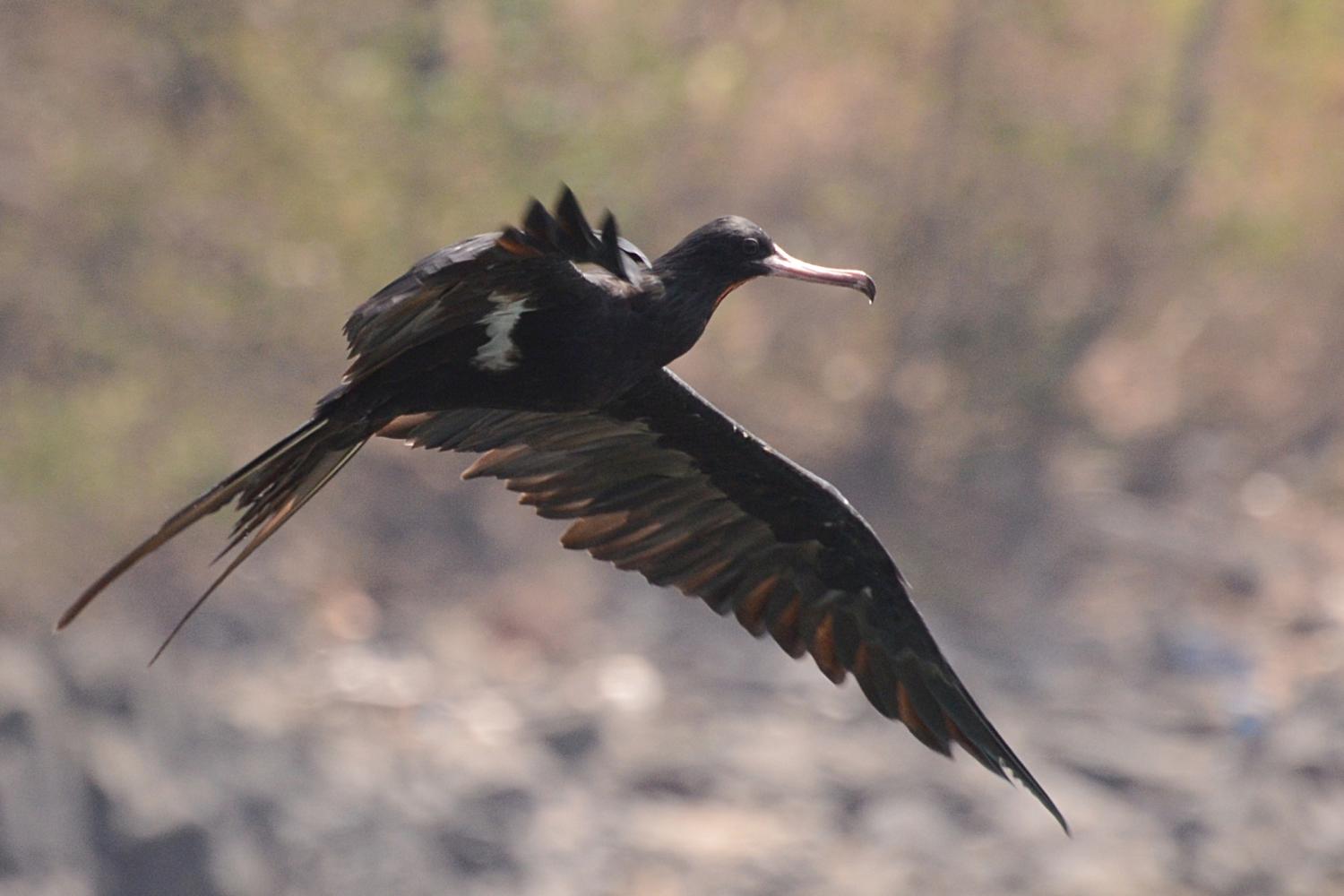Species of Thailand
Lesser frigatebird
Fregata ariel
George Robert Gray, 1845
In Thai: นกโจรสลัดเล็ก
The lesser frigatebird (Fregata ariel) is a seabird of the frigatebird family Fregatidae. At around 75 cm (30 in) in length, it is the smallest species of frigatebird. It occurs over tropical and subtropical waters across the Indian and Pacific Oceans as well as off the Atlantic coast of Brazil.
The lesser frigatebird is a lightly built seabird with brownish-black plumage, long narrow wings and a deeply forked tail. The male has a striking red gular sac which it inflates to attract a mate. The female is slightly larger than the male and has a white breast and belly. Frigatebirds feed on fish taken in flight from the ocean's surface (often flying fish), and sometimes indulge in kleptoparasitism, harassing other birds to force them to regurgitate their food.
Taxonomy
The lesser frigatebird was first described as Atagen ariel by the English zoologist George Gray in 1845 from a specimen collected on Raine Island, Queensland, Australia. The lesser frigatebird is one of five closely related species belonging to the genus Fregata. The other four are: the great frigatebird (Fregata minor), the Christmas frigatebird (Frigata andrewsi), the magnificent frigatebird (Fregata magnificens) and the Ascension frigatebird (Fregata aquila). The genus is the only member of the Fregatidae family.
Description
The lesser frigatebird is the smallest species of frigatebird and measures 66 - 81 cm in length with a wingspan of 155 - 193 cm and long forked tails. Male birds weight 625 - 875 g. Female birds are heavier and weight 760 - 955 g. Like all frigatebirds the male has a large red sac on the front of the throat which is inflated during courtship. Courtship display also involves a variety of calls, bill rattling and spreading of the wings. The male is mostly all black save for a white patch on the flank which extends on to the underwing as a spur. Males also have a pale bar on the upper wing. Females have a black head and neck with a white collar and breast as well as a spur extending on to the underwing. The female also has a narrow red ring around the eye. Juveniles and immature birds are more difficult to differentiate but the presence of the spurs of white in the armpits is a helpful distinguishing sign.
Frigate birds are built for flying; they rarely swim and cannot walk but can manage to climb around the trees and bushes in which they nest. They have a very light skeleton and long narrow wings and are masters of the air. Their name probably derives from the fact that they harass other sea birds such as boobies and tropicbirds as they return to their nests from feeding, forcing them to disgorge their catch, which is then swooped upon and caught by the frigate birds before it reaches the water below. This practice seems to be more common among female frigate birds, but probably only accounts for a fairly small proportion of the diet, which mainly consists of squid and flying fish scooped up from the surface of the sea.
Distribution
The lesser frigatebird is said to be the most common and widespread frigatebird in Australian seas (Lindsey, 1986). It is common in tropical seas, breeding on remote islands, including Christmas Island in the Indian Ocean in recent years. These birds are most likely to be seen from the mainland prior to the onset of a tropical cyclone, and once this abates they disappear again.
Breeding
Breeding seems to occur between May and December in the Australian region. They nest in trees (on Christmas Island) and both sexes contribute to nest building and incubation and feeding of the young. One egg is laid which takes 6–7 weeks to hatch. Fledglings are not left alone for another seven weeks or so for fear that they may be attacked and eaten by other birds including other frigate birds. They remain in the nest for another 6 months or so until fledged but they are cared for and fed by their parents for quite a long time after that.
Status
The total world population is estimated to be several hundred thousand birds. At least 6, 000 pairs breed on the Aldabra Islands in the Indian Ocean and another 15, 000 pairs breed on islands off the north coast of Australia. The largest colonies are on the Phoenix Islands and Line Islands in the central Pacific Ocean. Nests placed on the ground are very vulnerable to predation by introduced species such as feral cats. The elimination of cats from Howland, Baker and Jarvis Islands has led to the reestablishment and growth of colonies. Baker Island had no nesting lesser frigatebirds in 1965 but after the elimination of the feral cats on the island in around 1970 the birds returned and in 2002 16, 200 individuals were recorded.
A south Atlantic population of lesser frigatebirds (subspecies F. a. trinitatis) once bred on the archipelago of Trindade, 1100 km east of Brazil. The main island was once covered in forest but after this was destroyed, overgrazing by the introduced goats prevented any recovery. A series of eradication programs in the second half of the 20th century eliminated all the introduced vertebrates other than house mice. Feral cats that had seriously depleted ground nesting birds were finally eradicated in 1998. In 1975-1976 the American ornithologist Storrs Olson visited the island and reported seeing a small colony of 15 nests on a rocky islet just off the coast. Since this date there have been no further reports of lesser frigatebirds nesting on the island.
Because of the large population and extended range the species is classified by the International Union for Conservation of Nature as being of "Least Concern".
This article uses material from Wikipedia released under the Creative Commons Attribution-Share-Alike Licence 3.0. Eventual photos shown in this page may or may not be from Wikipedia, please see the license details for photos in photo by-lines.
Category / Seasonal Status
Wiki listed status (concerning Thai population): Winter visitor
BCST Category: Recorded in an apparently wild state within the last 50 years
BCST Seasonal status: Non-breeding visitor
Scientific classification
- Kingdom
- Animalia
- Phylum
- Chordata
- Class
- Aves
- Order
- Suliformes
- Family
- Fregatidae
- Genus
- Fregata
- Species
- Fregata ariel
Common names
- Thai: นกโจรสลัดเล็ก
Subspecies
Fregata ariel ariel, George Robert Gray, 1845
Range: Occurs in the central and eastern Indian Ocean, the seas off South East Asian and from northern Australia to the west and central Pacific Ocean.
Fregata ariel iredalei, Gregory Macalister Mathews, 1914
Range: It occurs in the western Indian Ocean and breeds on the Aldabra atoll.
Fregata ariel trinitatis, Alípio de Miranda-Ribeiro, 1919
Range: It occurred in the South Atlantic off the coast of Brazil and bred on the island of Trindade but may now be extinct.
Conservation status

Least Concern (IUCN3.1)
Photos
Please help us review the bird photos if wrong ones are used. We can be reached via our contact us page.
Range Map

- Bangkok Coast
- Khemarat District, Ubon Ratchathani
- Khlong Saeng Wildlife Sanctuary
- Ko Lanta National Park
- Ko Samui District, Surat Thani
- Laem Pak Bia
- Mueang Chonburi District, Chonburi
- Mueang Phuket District, Phuket
- Mueang Prachuap Khiri Khan District, Prachuap Khiri Khan
- Pak Thale
- Phetchaburi Coast
- Phi Phi Islands
- Samut Songkhram Coast


